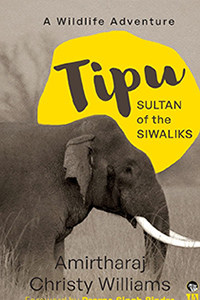“An intimate glimpse into the world of the Indian elephant.”
NO MAJOR SPOILERS
Elephants in India are a troubled species – despite being worshipped in the well loved form of Lord Ganesha, the elephant headed, they are increasingly at the mercy of growing habitat encroachment. Every so often the papers will report the death of a pachyderm on the railway tracks or a herd invasion of sugar cane fields leaving trampled huts in their wake. There is also a feeling that Indian and Asian elephants are rather overlooked and their magnificent and equally threatened African counterparts dominate the limelight and attract more attention among wildlife fans. To offset this impression and highlight the plight of the Asian elephants, Amirtharaj Christy Williams wrote a memoir of his work researching and collaring elephants, primarily in Rajaji National Park.

The book is aimed at young adults and focuses on the elephants Williams got to know, especially Tipu, who gives his name to the book, a giant of his species who raided fields and huts and made a nuisance of himself in his quest for food but did not harm human beings. There is the matriarch Mallika who lost her calf to a train and who displayed incredible courage in trying to stand up against a thundering locomotive and who set the stricken driver of the train on a course of conduct that would ensure few elephants suffered the same fate. Williams highlights his learning curve and the mistakes he made along the way with sometimes hilarious results.
Williams portrays the complexity of elephant society, the threats it faces and the problems that those researching them encounter, offset by the attitudes of villagers threatened by land encroachment when the land that they are based on actually belongs to the forest creatures and they have no real right to be there.
Sometimes humorous, often tragic, the book will provide wild life lovers with an intimate glimpse into the world of the Indian elephant and perhaps set them wondering how these noble creatures can be helped to co-exist with people, so that the planet can thrive along with the forests in which they live.
Reviewed by:
Anjana Basu
Added 16th June 2022




